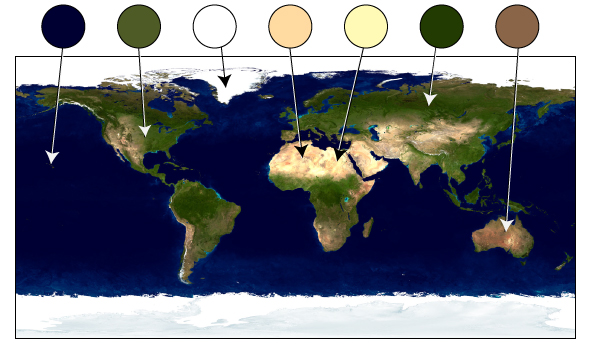Albedo and Climate
The surface of the Earth is a patchwork of many colors. Some of the colors are dark, such as the blue of the ocean, brown soil, and green forests. Other colors are pale, such as yellow desert sands and white ice.

A sampling of Earth's colors.
Credit: UCAR SciEd with NASA image
When sunlight hits pale colored surfaces, much of it is reflected, bouncing back out to space. When sunlight hits dark colored surfaces, very little of it is reflected. Most of it is absorbed.
The amount of energy reflected by a surface is called albedo. Dark colors have an albedo close to zero, meaning little or no energy is reflected. Pale colors have an albedo close to 100%, meaning nearly all the energy is reflected.
Forests, for example, have an albedo of about 15%, which means that 15% of the sunlight that hit a forest is reflected out to space. Fresh snow, on the other hand, can have an albedo of 90%, which means that 90% of the sunlight that hits a snow-capped peak is reflected out to space.
The amount reflected back out to space is called the planetary albedo. It’s calculated by averaging the albedo of all Earth surfaces – including the land, ocean, and ice. Above the Earth surface, clouds reflect large amount of sunlight out to space too. Earth's planetary albedo is about 31% meaning that about a third of the solar energy that gets to Earth is reflected out to space.
Why do we care what happens to sunlight that gets to Earth? Understanding how much energy from the Sun is reflected back out to space and how much is absorbed becoming heat is important for understanding climate.
If Earth's climate is colder and there is more snow and ice on the planet, albedo increases, more sunlight is reflected out to space, and the climate gets even cooler. But, when warming causes snow and ice to melt, darker colored surfaces are exposed, albedo decreases, less solar energy is reflected out to space, and the planet warms even more. This is known as the ice-albedo feedback.